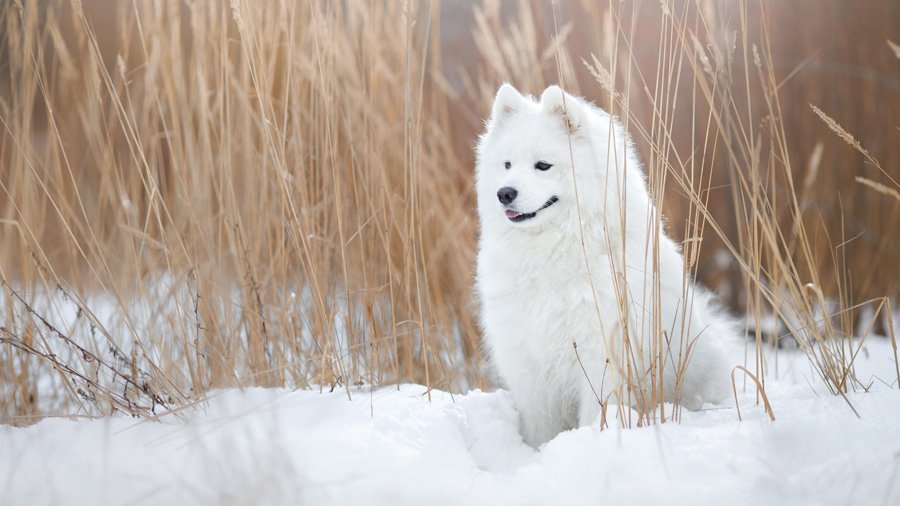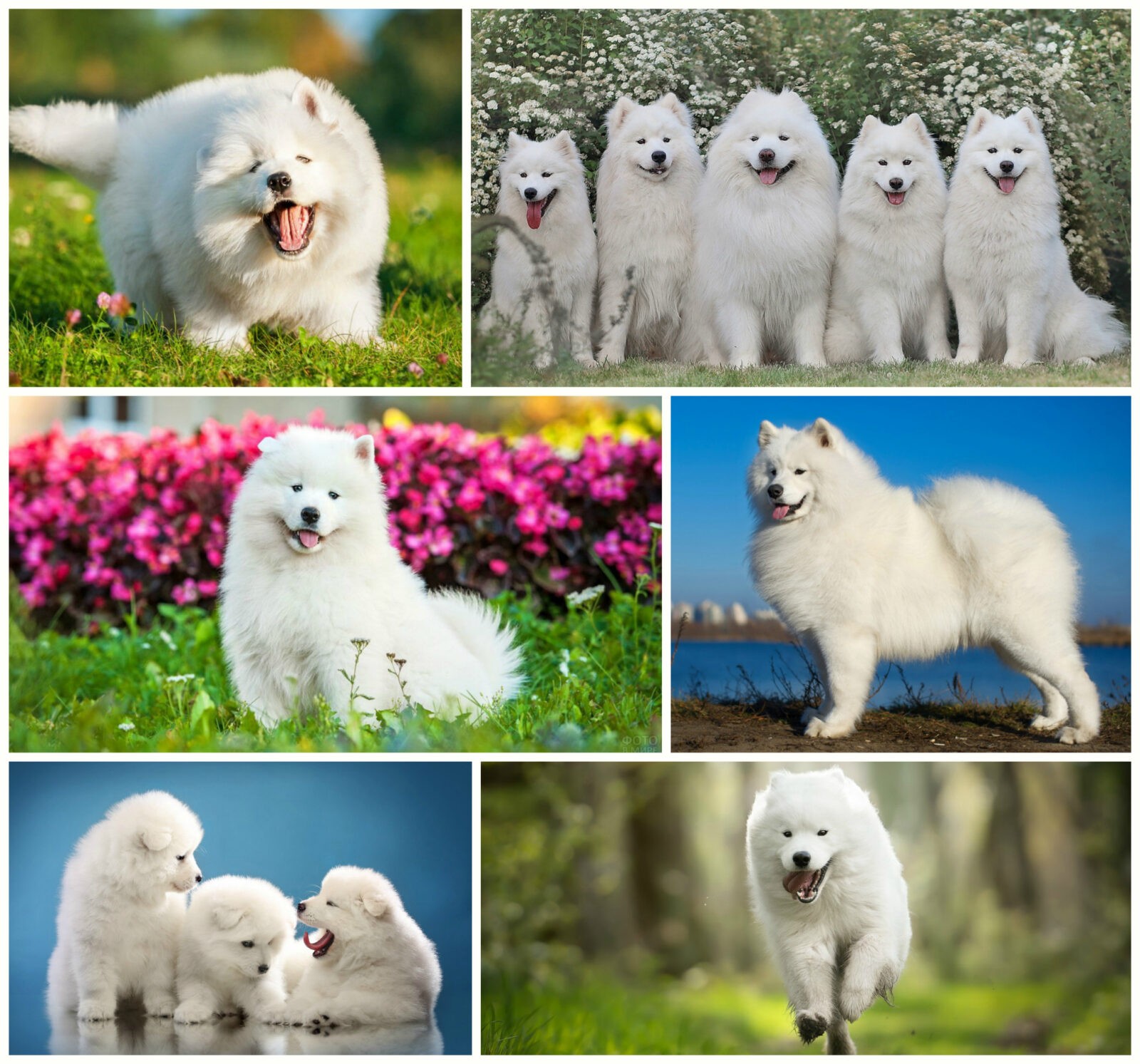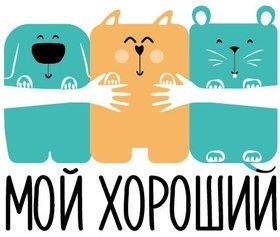
Basic information about the Samoyed breed
| Breed name: | Samoyed dog |
| Country of origin: | Siberia and northern Russia |
| The time of the birth of the breed: | 11th century BC e. |
| Type of: | spitz and primitive breeds |
| The weight: | 15 – 30 kg |
| Height (height at the withers): | 50 - 55 cm |
| Life Expectancy: | 12 - 15 years old |
|
ICF classification:
|
Group 5, Section 1, Room 212 |
| Puppies price: | 200 – 1500 $ |
| Most popular nicknames: | list of nicknames for samoyed |
Assessment of the characteristics of the Samoyed breed
| Adaptability
(a definition meaning how easily a dog can adapt to changes in life) |
🐶🐶🐶🐶 |
| Shedding level
(Level and frequency of hair loss in the animal) |
🐶🐶🐶🐶🐶 |
| Tenderness level
(The level and amount of tenderness and affection that the dog gives in return for attention to itself) |
🐶🐶🐶🐶🐶 |
| Exercise needs
(Dog's daytime activity level) |
🐶🐶🐶🐶 |
| Social need
(The required number of contacts of the dog with other animals, as well as people) |
🐶🐶🐶🐶 |
| Apartment content
(A factor that determines the level of noise and other inconveniences that a dog can deliver to owners in relation to the size of the apartment to the size of the dog) |
🐶🐶🐶 |
| Grooming
(The number of bathing, brushing, and the number of professional grooming sessions required for the dog) |
🐶🐶🐶🐶 |
| Friendliness in an unfamiliar environment
(Features of the behavior of a dog in a society with strangers or in an unfamiliar environment) |
🐶🐶🐶 |
| Tendency to bark
(Tendency to bark and its frequency and volume) |
🐶🐶🐶🐶 |
| Health issues
(Potential health status of the dog) |
🐶🐶🐶 |
| Territoriality
(The dog's tendency to protect his home, yard, or even his owner's car) |
🐶🐶🐶🐶🐶 |
| Friendliness to cats
(The tendency towards tolerance for cats and decreased manifestation of hunting instincts) |
🐶🐶🐶 |
| Intelligence
(The ability of the dog to think and solve emerging difficulties (not to be confused with learning!) |
🐶🐶🐶 |
| Education and training
(The level of difficulty in training the dog to perform certain actions) |
🐶🐶🐶 |
| Friendliness to children
(A factor that determines how friendly a dog is to children, whether he likes to play with them and tolerate some childish pranks) |
🐶🐶🐶🐶🐶 |
| Game activity
(The concept is determined by its very name, and, as a rule, is found in almost all dogs) |
🐶🐶🐶 |
| Observation
(The ability of a dog to detect the presence of a stranger on its territory) |
🐶🐶🐶🐶🐶 |
| Friendliness to other dogs
(The tendency of the dog to find common language with his other relatives) |
🐶🐶🐶🐶 |
Brief description of the Samoyed breed
Samoyed dogs (often called Samoyeds, or Samoyed huskies) have a height of about 55-60 cm in males and 50-55 cm in females, the weight of dogs ranges from 25-30 kg in males and 15-25 kg in females. The body of the Samoyed is strong, somewhat longer than the height at the withers, the neck is developed, muscular, the limbs are straight, with highly developed muscles, the tail is high, in an excited state it is thrown over the back or side. The head of the dogs has a wedge-shaped shape, the muzzle gradually tapers towards the nose, the ears are erect, have a triangular shape. Special pride of Samoyeds - thick and long coat with a soft and fluffy undercoat. The dogs have a luxurious collar around the neck, long hair covers the hind limbs and tail, while on the muzzle and front legs it is much shorter. Samoyed coat color - white (sometimes with pale fawn markings) or cream.
Samoyed dog photo:

The history of the origin of the Samoyed
It is known for certain that the Samoyed dog - one of the oldest breeds, since the first memories of these amazing animals were first found several hundred centuries ago among the ancestors of the current small peoples of the North. Presumably, Samoyed dogs helped people in hunting and gathering as early as the 11th century BC. The appearance and character of the dog suggests that the breed appeared in the process of domestication of the polar wolf. And indeed, when comparing the Samoyed dog and the polar wolf, similar features are definitely guessed. - the ability to live in extremely cold conditions, unpretentiousness in food, thick white (or with a creamy tint) coat. But this origin - only one version.
According to other versions, the Samoyed dog - a descendant of aboriginal Nenets Laikas (reindeer spitz), ancient inhabitants of the cold tundra. For centuries, these dogs guarded the plagues of the inhabitants of the North from wolves, helped them during the hunt, accompanied them in the impenetrable snowy wilds. But this idea of the origin of the breed is not the last.
One of the most common versions of the origin of the breed is the one according to which the British scientist E.K. Scott in 1889, after traveling to the territory of the Samoyed tribes, brought to England several aboriginal Samoyeds who helped the inhabitants of the North in everyday life. And only then these and other native dogs were crossed to develop a new breed - the Samoyed. By the way, there are several different options for the appearance and distribution of Samoyeds. Who knows where the truth lies. One thing is known - homeland of the Samoyeds - This is the territory of the current Russian Federation.
The nature of the Samoyed dog breed
Maintenance and care
Samoyed dogs can live both indoors and on the plots of suburban or private houses, provided that an aviary and a booth are equipped for them. They tolerate heat well, and especially cold. The dog's sleeping place should be equipped with a moderately hard and spacious bed, close to which a bowl of water should stand around the clock.
First of all, the new owner of the Samoyed should decide what will be the role of the dog in the future. Will a puppy grow into a simple home friend or a champion with titles. From this it follows that the care of the dog, of course, can be different. - more complex and meticulous, if in the future the Samoyed will have an exhibition life. But if the owner does not plan to make a celebrity out of the dog, then (surprisingly) there will be nothing difficult to care for.
Consider the features of caring for a domestic dog. The snow-white coat of a Samoyed dog requires shampooing no more than 1-2 times a year, since Samoyeds have a unique property of self-cleaning wool. They practically do not have a specific smell, characteristic of many fluffy dogs. Shedding occurs 1 (in males) or 2 (in females) times a year. Thick coat all season (and especially when shedding) requires careful combing with brushes and slickers. Regular brushing is the best way to clean a dog's coat. As necessary, Samoyeds should clean their ears with cotton pads using cleansers. Samoyed claws should be trimmed by the owner with a nail cutter, and hair around the fingertips should be removed carefully with scissors.
No specific advice can be given regarding the nutrition of these dogs. It is advisable to ask the breeder before buying a dog about the diet that was "native" for the puppy. A sudden change in diet can adversely affect the dog's digestive system. In the future, the Samoyed will be happy to gobble up both ready-made (only high-quality) dry food, and prepared by the owner. But you should not feed the dog with food from the table, although the Samoyeds are practically omnivores, but rich in spices, fatty and fried foods will certainly not benefit the animal.
Since the Samoyed dog is a cheerful and active breed, it is advisable to walk the dog at least 2 times a day, and active pastime is desirable. In extreme heat, the dog may feel unwell due to overheating, so it is wiser to take a promenade in the morning and evening hours. It is good to buy special toys for dogs - tweeters, bones, balls. Communication and playing with a dog of this breed is an indispensable condition for keeping.
Training and education
Health and disease of the Samoyed dog breed
Most often Samoyeds - healthy guys, but there are diseases that still occur in them. Such unpleasant diseases include:
- Eye diseases (cataracts, primary glaucoma, retinal atrophy and dysplasia) - the owner should pay attention to the symptoms: redness of the eyes, clouding of the lens, lacrimation, depression of the dog, etc.;
- Diseases of the cardiovascular system (aortic stenosis) - the animal suffers from shortness of breath, blue mucous membranes, fainting may be present;
- Liver disease (portosystemic shunt) - symptoms are often absent, sometimes there is insufficient body weight, poor coat condition, gastrointestinal disorders;
- Kidney disease (renal dysplasia and failure) - temperature fluctuations, increased thirst, vomiting, rare urination, etc .;
- Diseases associated with metabolic disorders (diabetes, etc.) - changes in the level of appetite, weakness, gastrointestinal disorders, thirst, etc .;
- Joint diseases (hip dysplasia, osteoarthritis) - lameness, fatigue, change in gait;
- Hearing loss (congenital deafness) - the dog does not respond to the call, the command, the coordination of movements is often disturbed.
Despite the above list, Samoyeds - it's more healthy dogs. But if alarm bells are found, the owner should immediately seek help from a veterinarian. Important for Samoyeds, as well as for other breeds of dogs, timely vaccinations. Preventive measures to combat parasites should also be carried out by the owner on time.
Some interesting facts
- It is generally accepted that the breed got its name in honor of the Samoyed people (they are also Samoyeds). But there is such an old legend that says that the dogs are so named because, thanks to their white coat, they were not visible in the snow when they were carrying sleds. In a blizzard and at night, the dogs completely merged with the snow cover, which created the impression that an unknown force was harnessed to the sled, as if they were riding on their own (“they are riding” - "Samoyed").
- These smart and hardy dogs more than once participated in polar expeditions (by R. Amundsen and others), saving people's lives at the cost of their own health. They say that since ancient times Samoyeds used dogs as nannies for children in especially severe frosts, when babies in tents clung to the warm body and thick wool of huskies, and they saved them with their warmth. It is not for nothing that you cannot find bad reviews about this breed, Samoyed dogs do not leave anyone indifferent - big, white, with intelligent eyes. Samoyeds - real stars of the Russian North!
- There is a wonderful poem by L. and A. Markelov “Ode to Samoyed”, which spiritually reflects the essence of this wonderful breeds.
Nurseries and breeders
We borrowed material from the wonderful site of our partners DOGCATFAN.COM about cats and dogs, the author dogcatfan
